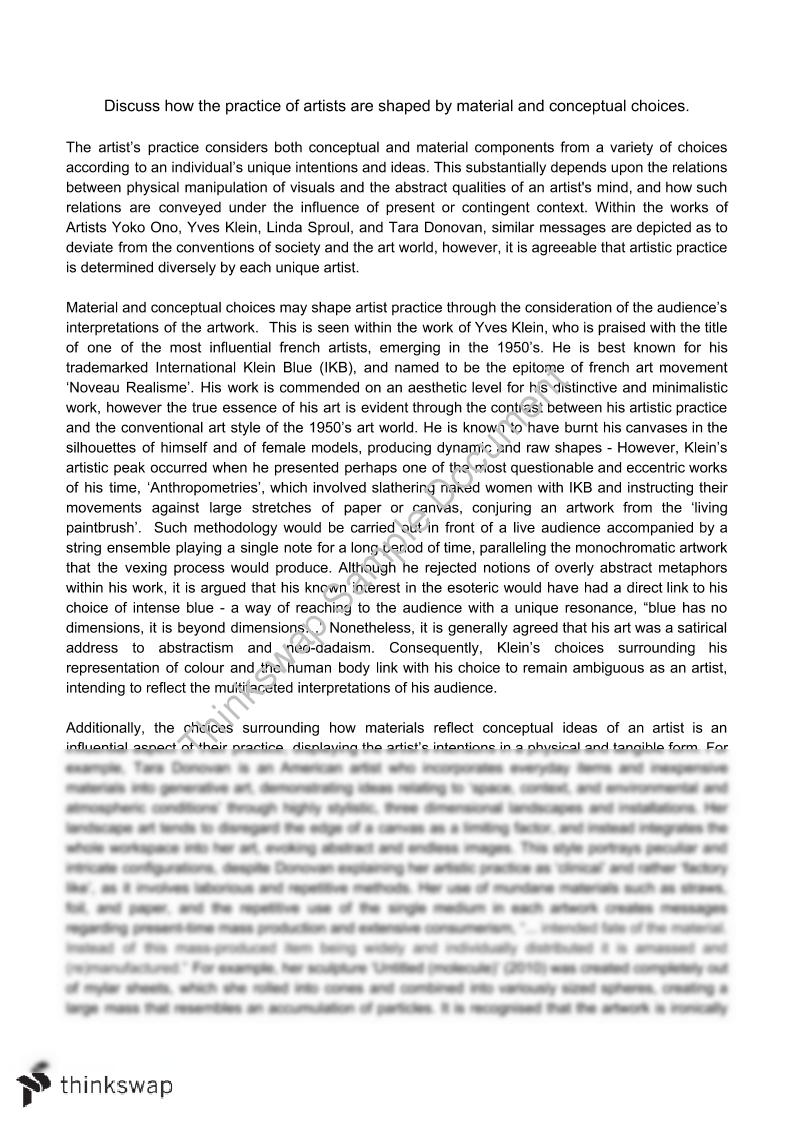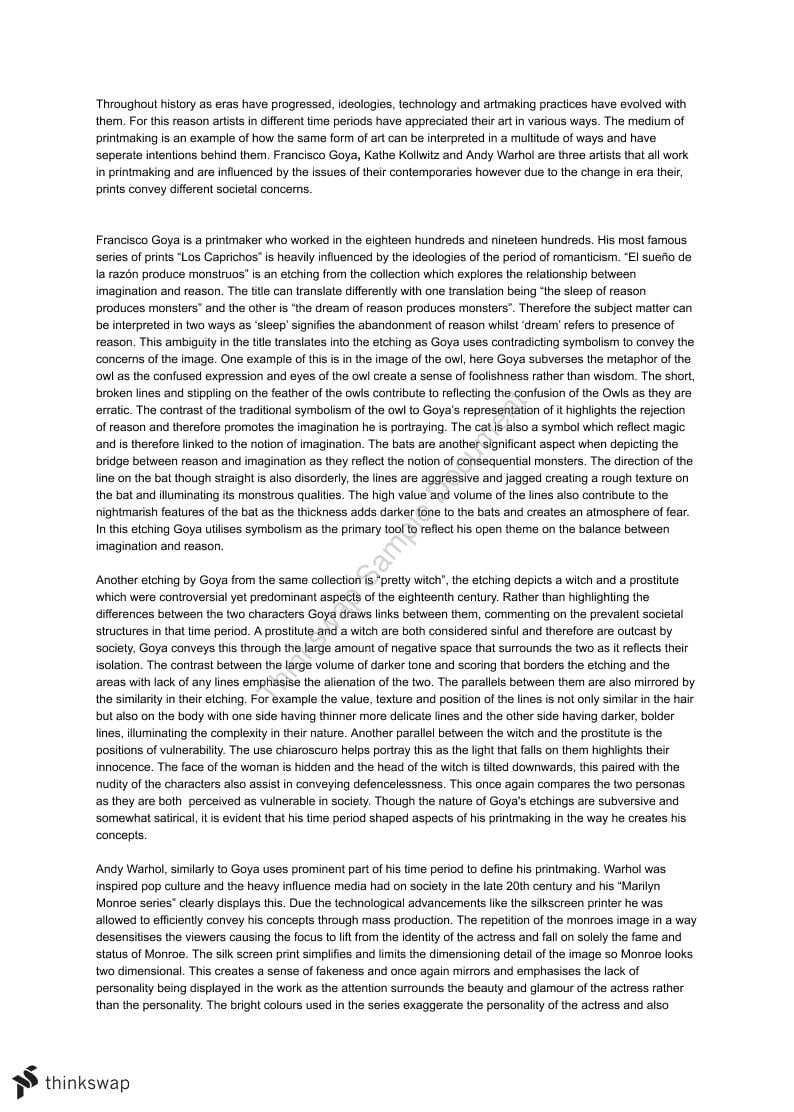
Words Essay On Art. Each morning we see the sunshine outside and relax while some draw it to feel relaxed. Thus, you see that art is everywhere and anywhere if we look closely. In other words, everything in life is artwork. The essay on art will help us go through the importance of art and its meaning for a better understanding Feb 17, · University/College: University of Arkansas System. Type of essay: Essay. Art is the product of creative human activity in which materials are shaped or selected to convey an idea, emotion, or visually interesting form. The word art can refer to the visual arts, including painting, sculpture, architecture, photography, decorative arts, crafts, and other visual works that combine materials or 5/5(1) What is Art? essaysArt has been a part of our life for as long as humanity has existed. For thousands of years people have been creating, looking at, criticizing, and enjoying art. I would like to address three questions: what is art, what is its purpose, and why has it survived for this long
Art Essays | Bartleby
It can be said that writing about art came to provenance throughout The Age of Reason or The Age of Enlightenment, essays about art, with the critical texts written mainly by philosophers such as Denis Diderot and as Johann Joachim Winckelmann.
Art essay as a specific form of exploring certain aesthetic and formal issues appeared with the rise of modernity. Various intellectuals differing in professions started grasping the impact both historical and modern art had on human thought and the society. Some essays were so innovative and radical that they changed to course of the art history, sending it in entirely new directions.
To bring you closer some of the most important essays written during the second half of the twentieth century we selected seven prolific examples which shook the way we understand and interpret art. Featured image: Reader with On Photography by Susan Sontag. Image via Flickr. Why Have There Been No Great Women Artists? was written by Linda Nochlinone of the essays about art important feminist art historians, essays about art.
At the time Nochlin was teaching art history at Vassar, essays about art, and after reading the second-wave feminist publications such as Redstockings Newsletter and Essays about art her work took a different direction. The following year during a Vassar graduation ceremony, Nochlin spoke with an art dealer Richard Feigen, who expressed his desire to represent women artists and asked her a simple question: Why are there no great women artists? After it was published, it almost instantly became an influential text since Why Have There Been No Great Women Artists?
was the first major art essay of the field. Nochlin underlined that art history is a male-dominated Western construct by delivering her innovative methodological approach through four chapters The Question of the NudeThe Lady's AccomplishmentSuccessesand Rosa Bonheur ; the renowned art historian argues that " the essays about art art historian should pick apart, analyze, and question the social and institutional structures that underpin artistic production, the art world, and art essays about art. Featured image: Artemisia Gentileschi - Judith Beheading Holofernes, Oil on canvas, Museo Nazionale di Capodimonte.
Although the second art essay on our top list deals with the entirely different subject matter, it is as relevant as the previous one. Through his text titled Artworldthe influential American art critic and philosopher Arthur C. Danto explored the notion of interpretation by explaining this particular phrase. and a quick answer - the Artworld. Featured image: The Russian edition of Arthur C. Danto's The Artworld, published by The Garage.
This is perhaps the most debated essay in art history - Avant-Garde and Kitsch by Clement Greenberg in In general, Greenberg perceived the erection of the avant-garde as a sort of an urgency to protect aesthetic standards from declining to kitsch imposed by the mass-production of consumer society.
At the same time, he argued that kitsch responds to Academic art by stating all kitsch is academic, and conversely, all that is academic is kitsch. Furthermore, Greenberg underlines the distinction between high art and low or popular art by bringing certain historical, social and political arguments; he claims that modern artistic practices inevitably became focused on the medium itself; they do not relate to the social world, and so they became self-sufficient.
Later in his career, essays about art, Greenberg distanced himself from certain points expressed in this essayand although it was widely debated and subverted by younger authors, essays about art, at the time when it was issued it was a radical text with several interesting propositions.
Featured image: A preview of Avant-Garde and Kitsch by Clement Greenberg, via thesilo. Walter Benjamin was and still is one of the crucial writers for the art world whose works are still celebrated and referred to today. In particular, the text The Work of Art in the Age of Mechanical Reproduction essays about art cited and explored in regards to the technological paradigm ever changed by the digital. Namely, this essay was issued in and it is based on the exploration of the notion of authenticity original vs.
fake expressed through the aura of a work of art devalued by mechanical reproduction. Looking from the critical Leftist Marxist stance, Benjamin argues the development of the artwork under capitalism; mechanical reproduction offers the artist a new way to think and produce artworks in the absence of traditional and essays about art value and make it a tool for sociopolitical transformation.
The Work of Art in the Age of Mechanical Reproduction greatly influenced the currents in art history, cultural essays about art, and media theory. Featured image: Unknown author - Portrait of Walter Benjamin, Source Akademie der Kunste, essays about art, Berlin - Walter Benjamin Archiv.
Image creative commons. InAmerican art critic and theorist, and essays about art founding member of the iconic October magazine, Rosalind E, essays about art. Krauss wrote the pivotal essay The Originality of the Avant-Garde.
By articulating the apparent copy, Krauss investigates the aesthetic and formal issues imposed by the electrifying relationship essays about art the original and the copy. Furthermore, Essays about art questions modernity while dissecting practices by artists spanning from Rodin to Sherry Levine and Carle Andre. Featured image: Rosalind Krauss - The Originality of the Avant-Garde.
Theory of the Avant-Garde is an essential text for understanding avant-garde and was written by German art theorist Peter Bürger in The author describes the early avant-garde movements as a fierce attack on the institution of art aimed essays about art merge art and life into one.
Bürger claims that this avant-garde agenda resulted in with the production of inorganic artworks, and although those artists finally failed in managing their aspirations, the author honors them for making a fundamental change in the development of modern art. According to Bürger, the institutional function of art in bourgeois society is governed by the principle of autonomy: as it detaches itself from life, it opposes itself to society by surrendering its ability to make a change.
The last essay on our list is called Against Interpretation and was written by the acclaimed author Susan Sontagbest known for her contribution to understanding photography, essays about art. Written init is part of a collection of essays which also includes On Style. With this particular textSontag proposed the transcendental power of art which was often taken for granted by the critics prone on constructing their intellectual readings.
Moreover, she underlined that the modern style of interpretation lost sensitivity due to intent to excavate or destroy a piece of art. Featured image: Susan Sontag photographed in her home, © Lynn Gilbert. September 22, Balasz Takac, essays about art. by Linda Nochlin Why Have There Been No Great Women Artists? The Artworld by Arthur C, essays about art. Danto Although the second art essay on our top list deals with the entirely different subject matter, it is as relevant as the previous one.
Avant-Garde and Kitsch by Clement Greenberg This is perhaps the most debated essay in art history - Avant-Garde and Kitsch by Clement Greenberg in The Work of Art in the Age of Mechanical Reproduction by Walter Benjamin Walter Benjamin was and still is one of the crucial writers for the art world whose works are still celebrated and referred to today. The Originality of the Avant-Garde by Rosalind Krauss InAmerican art critic and theorist, and the founding member of the iconic October magazine, Rosalind E.
Theory of the Avant-Garde by Peter Bürger Theory essays about art the Avant-Garde is an essential text for understanding avant-garde and was written by German art theorist Peter Bürger in Featured image: Peter Bürger - Theory of the Avant-Garde. Against Interpretation by Susan Sontag The last essay on our list is called Against Interpretation and was written by the acclaimed author Susan Sontagbest known for her contribution to understanding photography, essays about art.
How Andrew Wyeth Made A Painting
, time: 7:377 Important Art Essays | Widewalls

What is Art? essaysArt has been a part of our life for as long as humanity has existed. For thousands of years people have been creating, looking at, criticizing, and enjoying art. I would like to address three questions: what is art, what is its purpose, and why has it survived for this long Dec 03, · 10 Lines on What is Art Essay in English 1. The practising and learning art strongly correlates with reading and mathematics. 2. Art promotes social development, creativity and self-worth. 3. Only painting the lips of Mona Lisa, Leonardo da Vinci took 12 Estimated Reading Time: 6 mins Sep 22, · 7 Important Art Essays. It can be said that writing about art came to provenance throughout The Age of Reason or The Age of Enlightenment, with the critical texts written mainly by philosophers such as Denis Diderot and as Johann Joachim Winckelmann. Art criticism as an autonomous discipline/genre came to prominence in the 19th century with various thinkers and
No comments:
Post a Comment